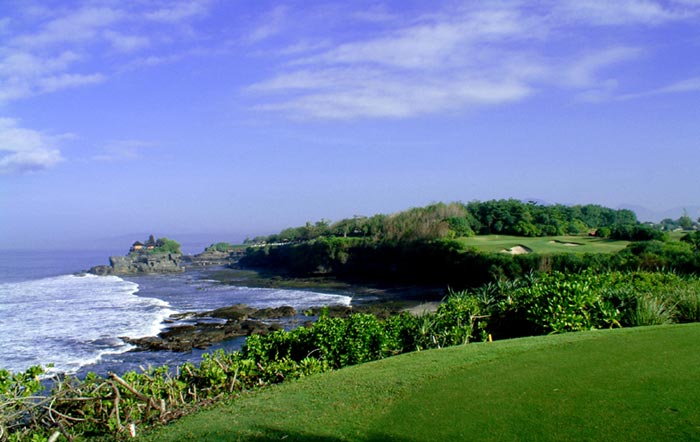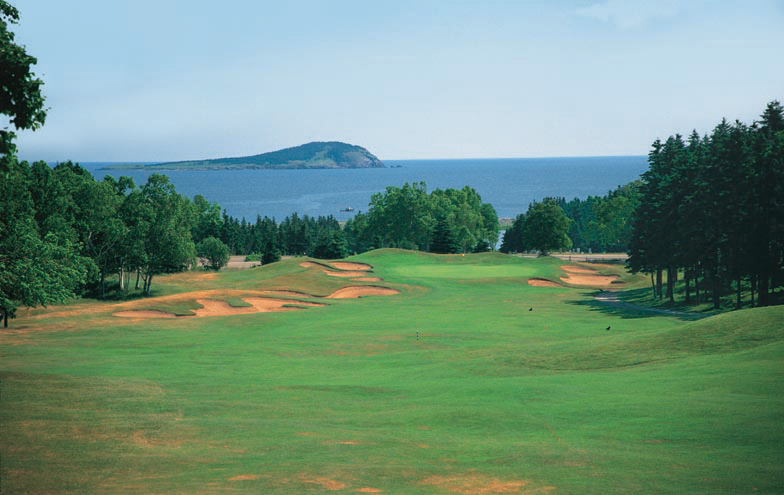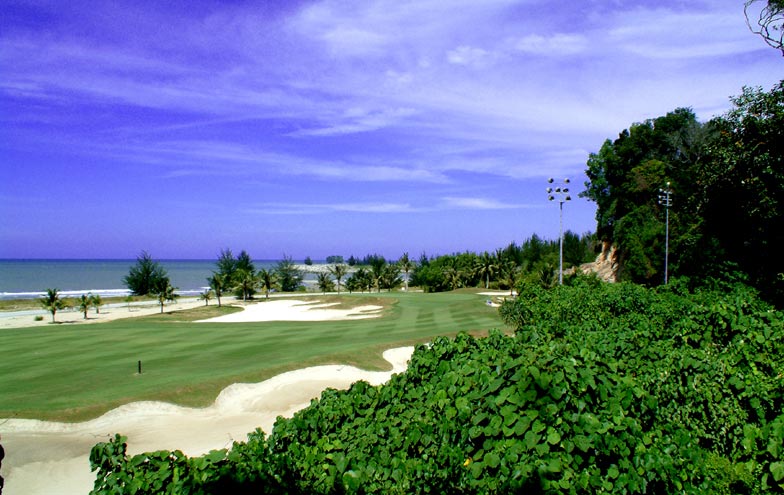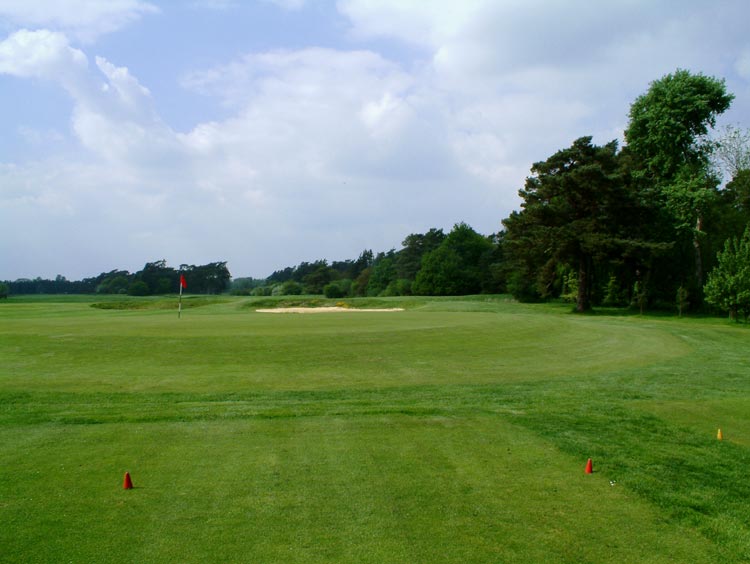Feature Interview with Ben Cowan-Dewar
June, 2004
Ben Cowan-Dewar is the President of GolfTI, a golf travel company based in Toronto, Canada, that he founded in 1999. GolfTI focuses on international luxury golf travel, which has taken him to some of the world’s great courses and helped fuel his love for golf course architecture. Ben helped organize the GolfClubAtlas.com Banff/Jasper 2004 Outing and will be a part of the 2005 Casa de Campo outing as well.
1. What do you do for a living?
- I run a company called Golf TI, which acts both as a tour operator for people to help book golf trips and a golf travel resource. We have 18-hole photo tours of every golf course we feature, which gives both past and future clients a chance to view the courses. We also have a new product that combines our interactive platform with a souvenir.
2. What is the goal of Golf TI?
- Our goal has been, and continues to be, to act as a top provider of golf vacations to the finest destinations in the world. With resorts in 14 nations across Europe, Asia, and North America, where we continue to expand, and with our foray into Australia and New Zealand beginning this fall, we feel we are right on track.
3. What are your clients after?
- The major requirement is simply world-class golf. Generally, that taste is coupled with a desire for great accommodations, great cuisine, and great service. The major split between our clientele is those clients who tend to look for a single-destination vacation, versus others who travel continuously throughout theduration of their trip.
4. What impressed you the most on your recent tour to Asia?
- Confined to one answer, I would have to say the ease of travel throughout Asia. Getting from one country to another is pleasant, efficient, and hassle-free. We travelled to Brunei, Indonesia, China and Singapore and found the people to be universally friendly and hospitable. Aside from that, the quality of golf was surprisingly great. Two resorts – The Empire Hotel and Le Meridien Nirwana Bali – would both stand out as two of the top resorts in North America, and yet they’ve gone largely unnoticed here.
5. What makes Nirwana Bali so special?
- A combination of elements contribute to its special vibe. Foremost is the setting, which is amazing, bordering the Indian Ocean with one of Bali’s most famous temples (Tanah Lot) sitting on a tiny rock island just off the shore. Rice fields are all over the course, which, according to Bob Harrison of Greg Norman Design, were sown to give a crop to the local Balinese people. That said, a great course is about more than just the setting. The whole flow of the course-the well-conceived bunkering, the rolling terrain-really gives the layout a special synergy to the land that you don’t always find in the generic resort golf course. The layout sort of sidles up to the ocean in a series of loops, so you’re there, and then drawn back inland, and then back, and so on. It retains this level of suspense and interest to the entire round, namely because there are great holes everywhere. The seventh (pictured below) is an obviously the great hole, but holes like the first and fourth are terrific standouts as well. The last thing that stands out about Bali is the people. They’re just great, charming and genuinely friendly. And, as a last peculiar aside, the caddies are all female, and are some of the kindest and most enjoyable company I’ve ever had on a golf course.

The great one shot seventh hole at Nirwana Bali
6. The Asian flu put a halt to golf course construction forseveral years. How is the golf course construction picture there at present?
- China and Korea seem to be fueling the growth, in a sense making up for the rest of the Asian continent. Mission Hills, the famous Chinese resort just to the north of Hong Kong, just opened their 10th course, which makes them the largest golf resort in the world. With so much land and cheap labour, the growth thereshould continue to be strong for a number of years.
7. What trip that you organize garners the most universal praise?
- I do not know whether it was universal, but the GolfClubAtlas 2004trip to Banff and Jasper really seemed to score with the participants. In general, though, the best feedback has been to the farther reaching places, like Bali and Brunei and places like Les Bordes in central France. It’s a pleasant surprise for seasoned golfers to find great resorts, and great courses, in places they wouldn’t expect.

Robert von Hagge's Les Bordes in the Loire Valley
8. Compare and contrast the merits of a game at Banff and Jasper Park.
- Both courses are among my personal favourites, but their differences are distinct. Banff’s setting is spectacular with the mountains, especially on the early holes, so there’s a sense of it being a special occasion from the first tee on. Jasper is set back somewhat from the same mountains, so the effect isn’t as pronounced, but the course itself is on a more interesting piece of land, with better movement. Banff’s great holes, like the fourth and 14th, are truly world-class, but Jasper has this depth about it. The set of par threes are extraordinary, and holes like eight breathe this unique life into the landscape. Jasper’s greens and bunkers are really the difference for me – to see the great photo of Banff’s 14th (formerly the 18th) in the clubhouse with its wild undulations leaves me to surmise that after they opened, Banff had the edge. In my mind, they’re very close, and I love them both, and would probably split 100 rounds evenly between them.
9. What are the greatest myths surrounding Cape Breton Highlands Links?
- The time it takes to get there! With no offence to Tom Doak and John Morrissett’s original CBH course profile for GolfClubAtlas, driving from Connecticut or New Jersey is not the way to go. There is a direct flight from New York to Halifax, which is less than 600 miles (shorter than flying to Chicago) and the connector up to Sydney, Nova Scotia is a simple transfer. From there, you have one of the most spectacular 90-minute drives to the resort. If the golfer prefers to drive from Halifax, it is no farther than Calgary is to Jasper. The place has a special feeling of remoteness, but unfortunately that’s kept some people from making the journey to see Thompson’s best work.

Cape Breton is worth every effort to see.
10. In addition to Cape Breton, what other single destination resortsdo you recommend?
- The Empire Hotel in Brunei was another delightful surprise in Asia. The hotel is among the most extravagant in the world, costing almost twice as much as the much lauded Burj Al Arab in Dubai. The course was designed by Nicklaus, and is a solid piece of work on the South China Sea. While Brunei has been slow to get into tourism-it’s never really been a necessity, with their oil and gas wealth-the people were very friendly and proud of their resort. Les Bordes, the famous French resort 90 minutes south of Paris, is another destination that combines striking beauty with great golf and hotel. The course is certainly famous in Europe, as Golf World has it at number two on their Top 100 in Continental Europe list. Robert von Hagge gets the design credit and the course seems to come from the 80s style of architecture that Dye was famous for at places like the TPC at Sawgrass. Combined with the serene setting of the Loire Valley… if you’re going to be in Paris, you just can’t pass up a night or two here.

The beautiful and challenging Empire Country Club in Brunei
11. What resorts do the best job of not insulting their guests and dumbing down the challenge of the golf?
- PacificDunes, The American Club, Pebble Beach, Kiawah Island, Pinehurst, The Homestead, Pine Needles, Gleneagles, Turnberry, Banff, Jasper, Highlands Links, Brunei, Bali… I could go on. It’s refreshing to see modern resorts matching the elegant standards of the classics, rather than being generic, forgettable places. The unique success of Kohler and Bandon will hopefully give developers all the incentive they need to pursue developments that challenge conventional thinking.
12. What are the cornerstone developments in the evolution of resort golf?
- Harbour Town in the early 1970s seems to me to be a key moment. Then came more recent ones drawn from the list above: Bandon, The American Club and Kiawah Island. No surprise to find Pete Dye’s name behind so many of the most successful/original resort designs. The move away from what really are banal tracks has created a new generation of resorts. They’re exciting, they’re unique, and it’s no surprise they are now some of the most popular golf resorts in America today.
13. What new resort courses are generating the greatest buzz?
- Tom Doak’s work in Australia and New Zealand, along with Kauri Cliffs in New Zealand is getting people excited about the Southern Hemisphere. Pete Dye’s newest course at Casa de Campo in the Dominican Republic has generated a great deal of buzz, which is yet another reason for golfers who have not seen the Teeth of the Dog to go. Bovey Castle is another, which is Peter de Savary’s (of Skibo fame) latest development in the Southwest of England. There, Donald Steel’s firm renovated the old J.F. Abercromby course, and the castle is exceptional. I have a feeling that when a few of the new courses in South Africa open in the next couple of years, it too will become a huge drawing card.
14. What are the best value golf offerings at present?
- For top quality in the U.S., value has to be a relative term. Highlands Links is still a great value, despite the stronger Canadian dollar, and pretty much every golf resort in Asia is a bargain, though you do have to incur the extra expense of getting there.
15. How did you become interested in golf course architecture?
- I loved golf from a relatively young age, and was lucky to have a father who fueled that passion by taking me with him on golf trips. Architecture always went in hand in hand for me, as my father and I actually built a par three with various tees at our family farm. I remember as a kid watching the PGA tour and trying to gain some knowledge from the courses I saw there and on my travels, so I used to draw golf holes that reminded me of the ones of television. I have an old copy of The World Atlas of Golf that shows some wear and tear too.

An early Ben Cowan-Dewar design!

Stanley Thompson was lucky to precede the talented Ben Cowan-Dewar!
16. Do you see golf architecture becoming more of a driving force in people setting up their trips?
- Yes. It wasn’t David McLay Kidd’s name that caused Bandon to take off. Pete Dye has become a household name, as have many of the architects of today. Even if people do not know the architects by name, they know the common theme and if they enjoy a Fazio course in Florida, chances are they will seek out another course by him in their other travels. I think, as well, that pros getting credit for courses designed by an architect is fading. King Valley a course north of Toronto, which once bore Curtis Strange’s name, but today, and rightfully so, Doug Carrick gets the sole design credit.
17. What are some of the most interesting design features you have seen?
- The greens at National Golf Links on Long Island (as well as the entire course) are always in my golf thoughts. The Short green at National is probably the finest I have ever seen and makes me wish I could hit hundreds of shots over a lifetime to the various pins.Also, Stanley Thompson’s use of severe terrain at Capilano and Highlands Links is outstanding, and with his artistry, his greatest strength. To imagine that Thompson could route Highlands Links the way he did amazes me. Holes two and seven really stand out as two of the great holes, partly because the land’s contour is so good that bunkers are not needed (there are none on the second hole). The approach shot to the 12th hole at Swinley Forest is a personal favourite, with the approach into that green a particular highlight. If I ever played with someone who did not try to run the ball into that green, I would probably quit the game.
Everything at Royal Worlington and Newmarket stood out – particularly the routing, the atmosphere, bunkering and greens. The approach to the fourth and the fifth greens, as well as the subtle sit-the-ground bunkering stand out. The green and the area to the short left of it, on the sixth hole at Crystal Downs, although it would be nice to see those contours short left more in play.
The green complexes at Hidden Creek! Rod Whitman’s bunkering at Blackhawk. Obviously I could go on.

The uniqueness of Royal Worlington and Newmarket as seen from the third tee
18.What owner/developer has taken a risk on a development and seen it work out well?
- It would seem Mike Keiser’s risk at Bandon Dunes has been a moderate success (wink, wink!!). Mark Parnisen at Kingsbarns has had great success and shows no signs of resting on those laurels. I have a lot of respect for course owner/developer Ryan Vold, who in 1984 had a then unknown Rod Whitman design Wolf Creek in Ponoka, an hour’s drive from a significant population base. Those three developers all worked with good principles of designing a golf course and it has proven a successful strategy in drawing golfers long-term.
19. Do you see golf travel moving away from ‘golf-only’ trips?
- We are already seeing this trend, especially in the longer haul travel. The baby-boomers have been travelling together and golf is just one aspect of a great vacation. In South Africa, we are seeing this trend include game safaris, which we will be featuring as well, and in wine country, golf and the regional culinary experience are an increasingly popular pairing.
The End








